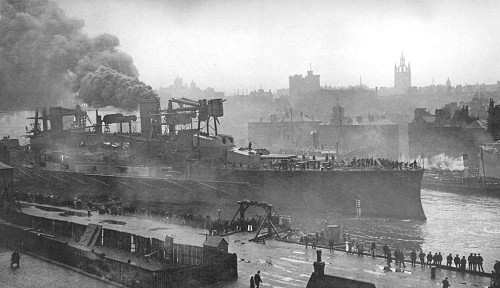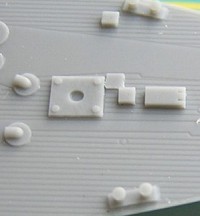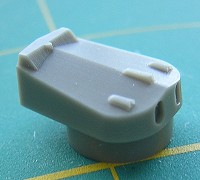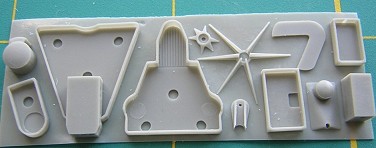
| KIT: | Combrig 1/700 HMS Agincourt (1918 fit) |
| KIT #: | 7-264 |
| PRICE: | $51.95 |
| DECALS: | no options |
| REVIEWER: | Mike Horrell |
| NOTES: | Resin |

| HISTORY |
Many books and articles have been written on the naval armaments race prior to WW1 and I will not attempt to recapture that era here. What is often overlooked however is the role of secondary powers in fueling that race.
By providing eager markets for commercially available warships built by the Great Powers’ shipyards, these countries at least partly financed the development of the shipyards and weapons that created the two great fleets that were to contest the North Sea from 1914-1918.
 South America was
an eager client for advanced warships as Brazil, Chile and Argentina spent
themselves into bankruptcy purchasing and deploying battleships larger and
more powerful than their rivals. In the process of doing so, Brazil went
completely over the top and in 1911 ordered Armstrong’s to build what was
to be the largest and most powerful battleship of its time; a 7 turreted
monster to be called Rio de Janeiro.
South America was
an eager client for advanced warships as Brazil, Chile and Argentina spent
themselves into bankruptcy purchasing and deploying battleships larger and
more powerful than their rivals. In the process of doing so, Brazil went
completely over the top and in 1911 ordered Armstrong’s to build what was
to be the largest and most powerful battleship of its time; a 7 turreted
monster to be called Rio de Janeiro.
Brazil’s economy collapsed before the ship was launched and the rusting hull sat on the builder’s ways for some time as another purchaser was sought. Eventually Turkey stepped up to the plate and Rio de Janeiro became the Sultan Osman I and work resumed in 1914.
With war rapidly approaching, the British government colluded with Armstrong’s to delay completion of the Sultan Osman I by stretching out the sea trials and on the formal declaration of war, seized both this ship and another conventional battleship from their Turkish crews. The furious Turks only too gladly accepted Germany’s offer a battlecruiser replacement, entered into a mutual defense pact with Germany and soon after declared war on England.
Now bearing her third name, HMS Agincourt (Gin Palace to her crew) joined the 1st battle Squadron of the Grand Fleet and fought at Jutland firing almost 150 rounds at the German High Seas Fleet. Somewhat the redheaded stepchild of the Grand Fleet, she saw little other action.
The Gin Palace was decommissioned shortly after the war and eventually scrapped in 1922 after attempts to sell her to several other countries failed.
To this day, no battleship has ever mounted as many guns in as many turrets. She was unique in both her history and her design, a little known giant from another era that was designed for one navy, sold to another and fought in a third.
Displacement: 27,500 tons. Speed: 22 knots (fast for her time) Armament: 14 12” guns in seven midline turrets, 20 6” guns, 10 3” guns Crew: 1100
| THE KIT |
As someone who has a large stash of early 70s 1/700 waterline ships that I am slowly working through, I have long wanted to “step up” from the somewhat toy-like early injected offerings such as I normally build and into the rungs of “serious” small scale ship modeling. Combrig is well known for producing exquisite resin ships in this “universal” scale so I recently purchased several of these for a long-term project.
 Agincourt is big
for a WW1 subject; almost 12 inches in length and two wide. That is plenty
of hull length to exhibit warpage, but there is none whatsoever. This is
unusual even in mainstream inject
Agincourt is big
for a WW1 subject; almost 12 inches in length and two wide. That is plenty
of hull length to exhibit warpage, but there is none whatsoever. This is
unusual even in mainstream inject ed kits which usually show some minor
upward warpage at both bow and stern requiring a few swipes across a sheet
of sandpaper to correct. The bow is subtly flared and with only a couple
exceptions the portholes are all of even size and properly aligned.
ed kits which usually show some minor
upward warpage at both bow and stern requiring a few swipes across a sheet
of sandpaper to correct. The bow is subtly flared and with only a couple
exceptions the portholes are all of even size and properly aligned.
The deck planking
is so tiny that it is almost invisible yet is straight and of even depth
along the entire length of the model. The various hatches and deck fittings
are crisply molded with delicate
 and precise detail
providing skylights, vents bollards and other fittings all of which “look
scale” and greatly enhance the ship’s realism.
and precise detail
providing skylights, vents bollards and other fittings all of which “look
scale” and greatly enhance the ship’s realism.
The detail parts, turrets, gun barrels ships boats, windlasses, davits, etc are all nicely molded, but my kit suffered some damage as all of this delicate resin is stuffed into one tiny bag and it’s almost impossible to avoid damage to something. There is no real excuse for this as the use of two small baggies would almost certainly have eliminated the problem.
 This brings up the
issue of the kit’s packaging. It’s terrible. The kit box is unbelievably
flimsy even by Russian standards and having WEM stuff it into a fold-over
cardboard mailer with no packing material at all certainly put it at almost
as great a risk crossing the Atlantic as the real ship faced at Jutland. I
have apprised WEM of my dissatisfaction over their packing methods, but I
doubt it will result in any change. Since these are delicate and moderately
expensive kits, poor packing is a factor to be taken into account in making
a purchase decision.
This brings up the
issue of the kit’s packaging. It’s terrible. The kit box is unbelievably
flimsy even by Russian standards and having WEM stuff it into a fold-over
cardboard mailer with no packing material at all certainly put it at almost
as great a risk crossing the Atlantic as the real ship faced at Jutland. I
have apprised WEM of my dissatisfaction over their packing methods, but I
doubt it will result in any change. Since these are delicate and moderately
expensive kits, poor packing is a factor to be taken into account in making
a purchase decision.
Resin ship models are designed to have relatively few parts compared to their injected equivalents and this kit has @ 70 parts over all.
| CONCLUSIONS |
Models of HMS Agincourt in ANY scale are hardly thick upon the ground so if you want to build it, here’s your only option. Still, this is a VERY nice kit and I’m glad I purchased it. I only hope that when it comes time to build it, I can do it justice.
| REFERENCES |
There are several books and many, many online historical references for the Gin Palace. For those with a real interest in the truly bizarre history of this ship (I have only briefly touched on her actual construction history) I would recommend both Google and Richard Hough’s book The Great Dreadnought; The Strange Story of HMS Agincourt, the Mightiest Battleship of WW1.
September 2005
If you would like your product reviewed fairly and quickly by a site that has around 300,000 visitors a month, please contact me or see other details in the Note to Contributors.